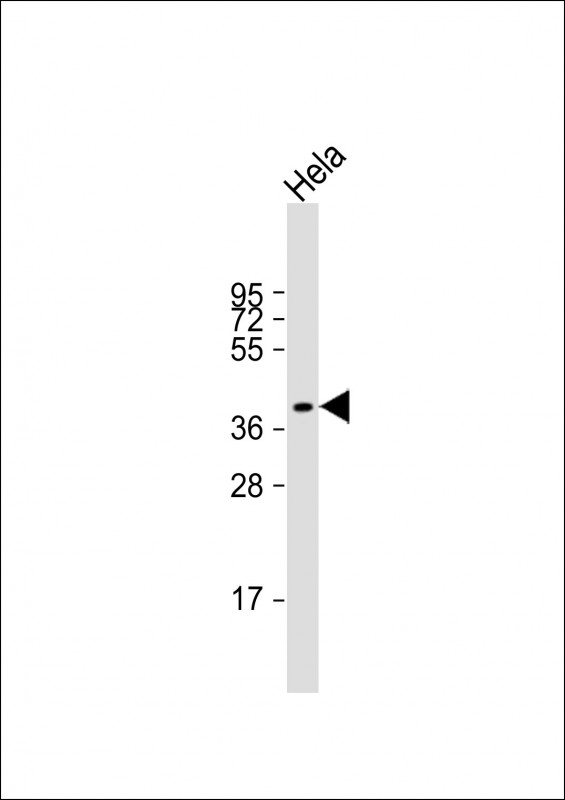LPGAT1 Antibody (Center)
Purified Rabbit Polyclonal Antibody (Pab)
- SPECIFICATION
- CITATIONS
- PROTOCOLS
- BACKGROUND

Application
| WB, E |
|---|---|
| Primary Accession | Q92604 |
| Reactivity | Human |
| Host | Rabbit |
| Clonality | polyclonal |
| Isotype | Rabbit IgG |
| Calculated MW | 43089 Da |
| Gene ID | 9926 |
|---|---|
| Other Names | Acyl-CoA:lysophosphatidylglycerol acyltransferase 1, 2.3.1.-, LPGAT1, FAM34A, KIAA0205 |
| Target/Specificity | This LPGAT1 antibody is generated from a rabbit immunized with a KLH conjugated synthetic peptide between 144-177 amino acids from the Central region of human LPGAT1. |
| Dilution | WB~~1:2000 E~~Use at an assay dependent concentration. |
| Format | Purified polyclonal antibody supplied in PBS with 0.09% (W/V) sodium azide. This antibody is purified through a protein A column, followed by peptide affinity purification. |
| Storage | Maintain refrigerated at 2-8°C for up to 2 weeks. For long term storage store at -20°C in small aliquots to prevent freeze-thaw cycles. |
| Precautions | LPGAT1 Antibody (Center) is for research use only and not for use in diagnostic or therapeutic procedures. |
| Name | LPGAT1 (HGNC:28985) |
|---|---|
| Function | Lysophospholipid acyltransferase involved in fatty acyl chain remodeling of glycerophospholipids in the endoplasmic reticulum membrane (By similarity). Selectively catalyzes the transfer and esterification of saturated long-chain fatty acids from acyl-CoA to the sn-1 position of 1-lyso-2-acyl phosphatidylethanolamines (1-lyso-PE, LPE), with a preference for stearoyl CoA over palmitoyl CoA as acyl donor (PubMed:36049524). Acts in concert with an unknown phospholipase A1 to convert palmitate phosphatidylethanolamine (PE) species into stearate ones. Provides substrates to the PE methylation pathway, controlling stearate/palmitate composition of PE and phosphatidylcholine (PC) species with an overall impact on de novo hepatic lipid synthesis, body fat content and life span (By similarity). Can acylate lysophosphatidylglycerols (LPG) using various saturated fatty acyl-CoAs as acyl donors (PubMed:15485873). Can also acylate monoacylglycerols with a preference for 2-monoacylglycerols over 1-monoacylglycerols (By similarity). Has no activity toward lysophosphatidic acids (LPA) (By similarity). |
| Cellular Location | Endoplasmic reticulum membrane; Multi-pass membrane protein |
| Tissue Location | Highly expressed in liver and placenta. Also expressed in peripheral blood, lung, kidney and brain. Detected at lower levels in colon. High expression is detected in brain and testis |

Thousands of laboratories across the world have published research that depended on the performance of antibodies from Abcepta to advance their research. Check out links to articles that cite our products in major peer-reviewed journals, organized by research category.
info@abcepta.com, and receive a free "I Love Antibodies" mug.
Provided below are standard protocols that you may find useful for product applications.
Background
Lysophoshatidylglycerol (LPG) specific acyltransferase that recognizes various acyl-CoAs and LPGs as substrates but demonstrates a clear preference for long chain saturated fatty acyl-CoAs and oleoyl-CoA as acyl donors. Prefers oleoyl-LPG over palmitoyl-LPG as an acyl receptor and oleoyl-CoA over lauroyl-CoA as an acyl donor.
References
Yang Y.,et al.J. Biol. Chem. 279:55866-55874(2004).
Ji D.,et al.Submitted (FEB-2004) to the EMBL/GenBank/DDBJ databases.
Nagase T.,et al.DNA Res. 3:321-329(1996).
Mural R.J.,et al.Submitted (SEP-2005) to the EMBL/GenBank/DDBJ databases.
If you have used an Abcepta product and would like to share how it has performed, please click on the "Submit Review" button and provide the requested information. Our staff will examine and post your review and contact you if needed.
If you have any additional inquiries please email technical services at tech@abcepta.com.













 Foundational characteristics of cancer include proliferation, angiogenesis, migration, evasion of apoptosis, and cellular immortality. Find key markers for these cellular processes and antibodies to detect them.
Foundational characteristics of cancer include proliferation, angiogenesis, migration, evasion of apoptosis, and cellular immortality. Find key markers for these cellular processes and antibodies to detect them. The SUMOplot™ Analysis Program predicts and scores sumoylation sites in your protein. SUMOylation is a post-translational modification involved in various cellular processes, such as nuclear-cytosolic transport, transcriptional regulation, apoptosis, protein stability, response to stress, and progression through the cell cycle.
The SUMOplot™ Analysis Program predicts and scores sumoylation sites in your protein. SUMOylation is a post-translational modification involved in various cellular processes, such as nuclear-cytosolic transport, transcriptional regulation, apoptosis, protein stability, response to stress, and progression through the cell cycle. The Autophagy Receptor Motif Plotter predicts and scores autophagy receptor binding sites in your protein. Identifying proteins connected to this pathway is critical to understanding the role of autophagy in physiological as well as pathological processes such as development, differentiation, neurodegenerative diseases, stress, infection, and cancer.
The Autophagy Receptor Motif Plotter predicts and scores autophagy receptor binding sites in your protein. Identifying proteins connected to this pathway is critical to understanding the role of autophagy in physiological as well as pathological processes such as development, differentiation, neurodegenerative diseases, stress, infection, and cancer.


